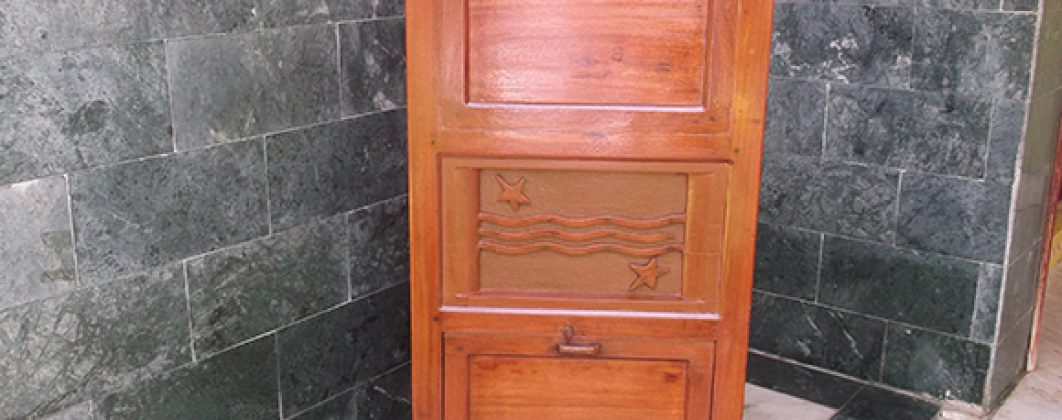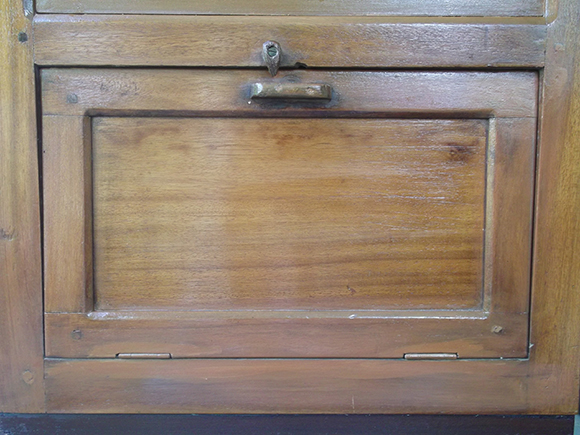
 This beautiful vintage wooden cabinet is made to store clothes meant for washing. Before the invasion of polyester or artificial fabric garments in India, both men and women used to wear cotton clothes. It was a tradition that once bath is taken in the morning every day, Indians used to wear washed clean cotton clothes invariably and kept the used clothes in a cane basket or a wooden cabinet that had enough ventilation. Those were the days when detergent soaps that clean clothes in a jiffy weren’t available yet. Every household used to have their own family washer man known as Dhobi in Hindi or Chakali in Telugu who will come once in 3or 4 days, collect the used clothes from the cane baskets or dirty cloths cabinet, wash them in a canal or tank or a traditional Dhobhi ghat known as Chaki Revu in Telugu.
This beautiful vintage wooden cabinet is made to store clothes meant for washing. Before the invasion of polyester or artificial fabric garments in India, both men and women used to wear cotton clothes. It was a tradition that once bath is taken in the morning every day, Indians used to wear washed clean cotton clothes invariably and kept the used clothes in a cane basket or a wooden cabinet that had enough ventilation. Those were the days when detergent soaps that clean clothes in a jiffy weren’t available yet. Every household used to have their own family washer man known as Dhobi in Hindi or Chakali in Telugu who will come once in 3or 4 days, collect the used clothes from the cane baskets or dirty cloths cabinet, wash them in a canal or tank or a traditional Dhobhi ghat known as Chaki Revu in Telugu.
The clothes were steamed with water mixed with soda powder called as chakali soda in Telugu before washing them in huge earthen pots and making them completely bacteria free. Washing cloths was and still is a professional job and clothes are given to the traditional professional washer men to be washed and ironed. The main source of income and livelihood generated by them is through washing the clothes. Then they used to iron the cloths and return them back to the owners.
Thus, it was a common practice in the old days that most of the houses used to have a covered basket to store the soiled clothes. Those who could afford used to have custom made wooden cabinets or boxes to keep the soiled clothes till the dhobi collected them. In my antique collection, I have one such excellently made vintage wooden cabinet made out of the rare jackfruit tree wood.



The Design of the used cloths box
The height of the box is 38 inches. The width and also the depth of the box is 18 inches. The cabinet is made to resemble a Radiogram, a combination of radio and gramophone record player which was a very popular entertainment system before the arrival of Television in Indian market. When the box was made in 1956, it was a fashion back then to have a radiogram in the drawing room and the family used to exhibit their social status by the class of radiogram they possessed. The carpenter who made this beautiful cabinet crafted it in such a way that it resembles a radiogram so that the box can be kept in the drawing room as well as a showpiece.




The front view of the cabinet appears as though it has 3 racks, a top rack to hold the record player, a middle rack for the radio, and the bottom rack to hold the record player discs. Actually, the entire cabinet is a hollow single box which has two openings, one opening on the top with a lid and another opening in the bottom with a drop down door held by a latch. The top lid is lifted and the soiled cloths are dropped inside. The clothes will be piled one on top of the other in the box as and when they are used and set aside. When the clothes are to be removed, the bottom door is pulled by unlatching the door latch. All the clothes can be pulled out effortlessly.




The other three sides of the box are made out of a single Jackfruit wood plank with vertical slots having 3 inches gap to provide ventilation to the clothes inside. Above 2 inches from the bottom of the box, there is a one inch black groove running on all four sides of the box like a ribbon. The whole box is imaginatively conceived and given a shape with beautiful finish. Even after 57 years, it still retained its charm and looks as beautiful as it did back then.
The Story of this antique wooden Cabinet
This beautiful wooden cabinet, known as Paatha Battala Butta in Telugu was commissioned by my father-in-law and mother-in-law in the year 1956. I was told that my mother-in-law, Machraju Satyavathi, was very particular about having a clothes cabinet exclusively made out of the ‘Jackfruit’ tree timber which was rare to find. There was an old Jackfruit tree in the gardens of my father-in-law ,Machraju Bhaskar Rao in their village ‘Vanapalli’ in the Konaseema area of Andhra Pradesh. The huge tree fell down one day due to cyclone and it was cut into planks so that furniture could be made out of the family owned tree. My father-in-law got one sofa set made out of the wood and my mother in-law insisted that a wooden cabinet for used clothes should be made with the remaining wood. I was told that the carpenter initially refused to make a wooden cabinet box for soiled clothes out of the pious wood of Jackfruit tree. But my mother -in-law was so fond of having one made that she persuaded the carpenter to make one with the best design he can think of and he crafted this amazing box, though a bit reluctantly.

Jackfruit Wood – Pious and Rare
Jackfruit tree wood is considered to be very pious and divine. This wood is mainly used by the Buddhist sculptors to make the statue of Buddha for temples. The main body of the traditional Indian stringed instrument Veena is also made out of the sacred Jackfruit tree wood which has excellent qualities of reverberation, durability and least vulnerability for moisture. Traditional south Indian drum called Mridangam and Kanjira are also made out of the wood of Jackfruit tree. In Kerala, where the jackfruit trees are cultivated widely, the Nambudri Brahmins sit on a plank made out of Jackfruit tree wood called Avani Palaka to perform the religious rituals.
The golden yellow Jackfruit timber with natural grains is used for making furniture, doors and windows, and in roof construction since it is termite-proof. The Jackfruit tree takes in the polish, beautifully highlighting the natural wood grains. This wood is also used as a dye by the Buddhist monks residing in forest monasteries to attain the characteristic distinct light brown colour of their robes. The sawdust or the chips of the Jackfruit timber, when mixed with alum, produce a rich yellow dye that is used to colour the cotton and the silk robes of Buddhist priests.
The Nambudri Brahmins of Kerala make sacred fire by rubbing the two dry branches of this tree.
Jackfruit Tree

The botanical name of the Jackfruit tree is Artocarpus Heterophyllus. The word ‘Jackfruit’ is derived from Malayalam word ‘Chakka’ and the Portuguese word ‘Jacca’. The species of the tree is from the Mulberry family. The evergreen tree reaches a height of 60 feet when fully grown. The Jackfruit tree is “cauliflorous” meaning that the Jackfruits are directly produced from the trunk. Unlike other fruits that naturally grow on tree branches, the Jackfruit is the only fruit in the world that grows directly from the trunk of the tree. On an average, each Jackfruit tree produces 30 to 150 fruits per year depending on the age of the tree and the variety. Each fruit weighs anywhere between 15 to 25 kilograms. The Jackfruit is also the largest tree bearing edible fruit. The Jackfruit tree is known in Hindi language as Chakki, Panos and Kanthal, in Bengali language as Katthal, in Malayalam and Tamil languages it is known as Pilaor, Pilavu respectively. In Telugu language it is known as Panasa.
How I Acquired the Box
This box was in use at my father- in-law’s place in Vijayawada where he was living a retired life with my mother-in-law, his son Purushothama Rao, and his daughter-in-law Parvathi, and his grandchildren Vani and Babi. My mother-in-law passed away in the year 1993, and Purushothama Rao passed away in 1996. Then my father-in-law shifted to Hyderabad and he passed away in the year 2002. Parvathi with her son Babi (full name is Bhaskar) and his wife Pradeepa moved into a flat and they acquired modern furniture suitable to the flat. This antique wooden box had no place or purpose in their flat. Knowing about my passion for collecting antiques, Parvathi gave this wonderful gift to me. This charming art work in divine panasa wood has a prized place in my antique collection.


Hope I have been able to refresh some memories from your childhood. If you had a similar box in your house, you would remember this for sure. If you haven’t, then now you know a bit about the way of life back in the old days and the significance that each item had in the household and the purpose it served. Also if you would like to be updated when I write my next blog post, please leave your email address in the subscription box below.
[subscribe2]

Copyright © 2021 YK Antiques Home Museum
3 Responses
Sir,Very nice to see your blog and the way respect the persons who have gifted Antique’s to you sir–Naveen
Dear Naveen , Thank you for visiting my website and your kind comments.Yes i should be grateful to the people who encouraged my passion for antiques and in some occasions donated some of the precious items.
Dear Naveen , Thank you for visiting my website and your kind comments.Yes i should be grateful to the people who encouraged my passion for antiques and in some occasions donated some of the precious items.